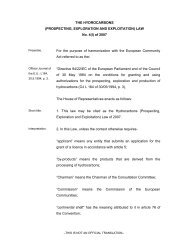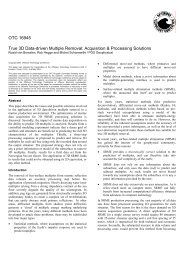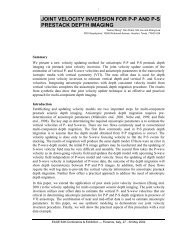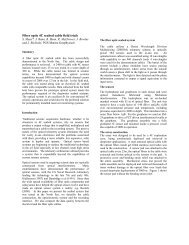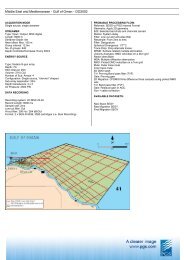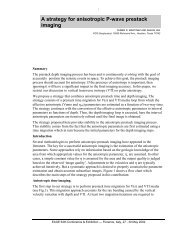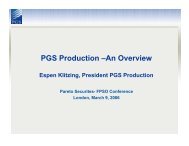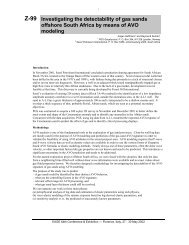Annual Report 2011 - PGS
Annual Report 2011 - PGS
Annual Report 2011 - PGS
Create successful ePaper yourself
Turn your PDF publications into a flip-book with our unique Google optimized e-Paper software.
Notes to the consolidated financial statements<br />
NOTES TO THE CONSOLIDATED FINANCIAL STATEMENTS<br />
Goodwill (and the cash-generating unit to which goodwill has been allocated) and intangible assets not yet available for use are<br />
tested for impairment annually, or whenever there is an indication that the asset may be impaired. If the recoverable amount of<br />
the cash generating unit is less than the carrying amount of the unit (including goodwill allocation), the impairment loss goes first<br />
to reduce the carrying amount of any goodwill and then to reduce the carrying amount of the other assets of the unit pro-rata on<br />
the basis of the carrying amount of each assets in the unit.<br />
Where an impairment loss subsequently reverses, the carrying amount of the asset (cash-generating unit) is increased to the<br />
revised estimate of its recoverable amount. That increased carrying amount cannot exceed the carrying amount that would have<br />
been determined had no impairment loss been recognized for the asset (cash-generating unit) in prior years. A reversal of an<br />
impairment loss is recognized immediately and presented separately in the consolidated statements of operations. Impairment<br />
loss recognized for goodwill cannot be reversed in future periods.<br />
Derivative financial instruments and hedging<br />
The Company accounts for derivative financial instruments in accordance with IAS 39 Financial Instruments: Recognition and<br />
Measurement (“IAS 39”). The Company uses derivative financial instruments to reduce risk exposure related to fluctuations in<br />
foreign currency rates and interest rates. Derivative instruments are recognized in the consolidated statements of financial<br />
position at their fair values while realized and unrealized gains and losses attributable to derivative instruments that do not<br />
qualify for hedge accounting are recognized as other financial items, net, as they arise.<br />
The Company applies either fair value or cash flow hedge accounting when a transaction meets the specified criteria in IAS 39<br />
for hedge accounting. To qualify for hedge accounting the instrument should be designated as a hedge at inception of a hedge<br />
relationship. At the time a financial instrument is designated as a hedge, the Company documents the relationship between the<br />
hedging instrument and the hedged item. Documentation includes risk management objectives and strategy in undertaking the<br />
hedge transaction, together with the methods that will be used to assess the effectiveness of the hedging relationship.<br />
Accordingly, the Company formally assesses, both at the inception of the hedge and on an ongoing basis, whether the hedging<br />
derivatives have been “highly effective” in offsetting changes in the fair value or cash flows of the hedged item. A hedge is<br />
normally regarded as “highly effective” if, at inception and throughout its life, it can be expected, and actual results indicate, that<br />
changes in the fair value or cash flows of the hedged item are effectively offset by the changes in the fair value or cash flows of<br />
the hedging instrument. Actual results must be within a range of 80% to 125%. Hedge accounting will be discontinued when (a)<br />
the Company determines that a derivative is not, or has ceased to be, highly effective as a hedge, (b) the derivative expires, or<br />
is sold, terminated or exercised, (c) the hedged item matures or is sold or repaid, or (d) a forecast transaction is no longer<br />
deemed highly probable.<br />
The Company accounts for hedges that meet these criteria as follows:<br />
Fair value hedges: The change in fair value of the hedging instrument is recognized in the consolidated statements of<br />
operations. The change in fair value of the hedged item attributable to the risk hedged is recorded as part of the carrying value<br />
of the hedged item and is also recognized in the consolidated statements of operations. When an unrecognized firm<br />
commitment is designated as a hedged item, the subsequent cumulative change in fair value of the firm commitment attributable<br />
to the hedged risk is recognized as an asset or liability with a corresponding gain or loss recognized in the consolidated<br />
statements of operations.<br />
Cash flow hedges: The effective portion of the gain or loss on the hedging instrument is recognized in the consolidated<br />
statement of comprehensive income, while any ineffective portion is recognized immediately in the consolidated statements of<br />
operations. Amounts recorded in the consolidated statement of comprehensive income are transferred to the consolidated<br />
statements of operations when the hedged transaction affects the consolidated statements of operations.<br />
Revenue recognition<br />
The Company recognizes revenue when persuasive evidence of a sale arrangement exists, delivery has occurred or services<br />
have been rendered, the sales price is fixed or determinable and collection is reasonably assured. The Company defers the<br />
unearned component of payments received from customers for which the revenue recognition requirements have not been met.<br />
Consideration is generally allocated among the separate units of accounting based on their estimated relative fair values when<br />
elements have stand alone value. If an element of a customer agreement does not have stand alone value, revenue is deferred<br />
and recognized over the period services are provided. The Company's revenue recognition policy is described in more detail<br />
below.<br />
(a) Sales of MultiClient library data<br />
Late sales - The Company grants a license to a customer, which entitles the customer to have access to a specifically defined<br />
portion of the MultiClient data library. The Company recognizes revenue for late sales when the customer executes a valid<br />
license agreement and has received the underlying data or has the right to access the licensed portion of the data, the<br />
customer's license payment is fixed and determinable and collection is reasonably assured.<br />
Volume sales agreements - The Company grants licenses to the customer for access to a specified number of blocks of<br />
MultiClient library within a defined geographical area. These licenses typically enable the customer to select and access the<br />
specific blocks over a period of time. Although the license fee is fixed and determinable in all cases, the payment terms of<br />
individual volume sales agreements vary, ranging from payment of the entire fee at the commencement of the agreement, to<br />
instalment payments over a multi-year period, to payment of the license fee as the specific blocks are selected.<br />
Revenue recognition for volume sales agreements is based on a proportion of the total volume sales agreement revenue,<br />
measured as the customer executes a license for specific blocks and the customer has received the data or has been granted<br />
access to the data and collection is reasonably assured.<br />
7 <strong>PGS</strong> ANNUAL REPORT <strong>2011</strong><br />
78 <strong>PGS</strong> <strong>Annual</strong> <strong>Report</strong> <strong>2011</strong>



